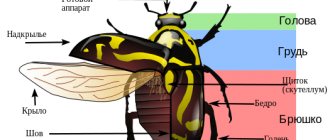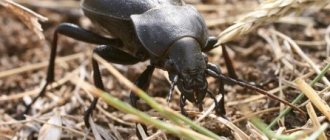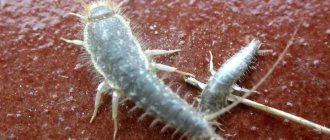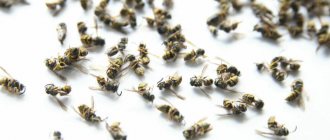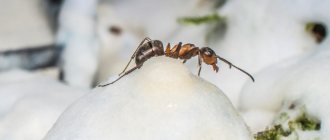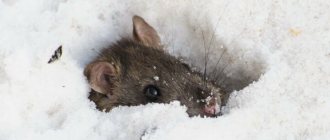How do bees winter?
Bees do not hibernate, although they spend the winter in a dry and warm place. For domestic insects, beekeepers create all the necessary conditions, but as for wild insects, they have to take care of themselves. There are several features that are inherent in this species. These include:
- slowdown and then complete cessation of egg laying by the uterus;
- the constant presence of insects in the nest during cold snaps, because they have to maintain a constant temperature for the development of the “younger generation”;
- When the first cold weather sets in, any bee flights stop, they form a lump or club and sit almost motionless. Moreover, only the upper part of this club is located on honeycombs, the rest is located on empty ones;
- if a warm day suddenly arrives, the insects leave their nest and go out to fly around the area. If the beekeeper hides the hives in a dugout or cellar, on such days they must be taken out. Flight is necessary to cleanse the intestines. The later it is produced, the better for the swarm;
- bees hibernate in the club all winter. As a rule, there are up to 35,000 individuals. The bee club is like a single organism. If the insect becomes cold, it will climb into the center, where the temperature is higher. If someone gets hungry, he will climb up to where the honeycombs are. The movement does not stop for a minute, although the club does not disintegrate until the very end of the cold weather;
- Empty honeycombs are used by bees as warm clothing; if an insect freezes, it can climb into the cell to bask, where it is warm and comfortable.
As you can see, bees are able to withstand the cold absolutely calmly. To do this, they have developed a unified mechanism of action that allows the swarm to remain viable.
Insects are able to survive even frost of -50 degrees in the club.
ladybugs
These harmless and cute guys are especially interesting. In summer, they are absolutely indifferent to other representatives of their species and do not even notice them. But before the onset of cold weather, ladybugs begin to look for their own kind and gather in flocks of several hundred and sometimes thousands of individuals. Together they find a warm shelter (it can be absolutely anything) and hibernate.
It is curious that the flock uses the same place every year.
By observing how insects prepare for winter, we can draw an unambiguous conclusion. They are not as stupid as they seem. Of course, all this happens at the level of instincts, but the complex processes of wintering look very interesting and even instructive to some extent.
Under the bark of the trees
The older the tree and the more loose its wood, the more six-legged winterers can be found in it. Bark beetles and wood borers penetrate into the very middle of the trunk. Butterflies, flies, and many Coleoptera climb into the cracks under the bark. Usually insects lay eggs for the winter and die themselves - this is their life cycle. It is much easier to overwinter under the roots of trees, in hollows and cracks, as well as in rotten stumps in the pupal stage - this phase occurs in the winter period for most butterflies.
Mosquitoes and flies
These annoying insects prepare for winter just like butterflies. In autumn, they look for a warm place to sleep and survive the cold. But flies and mosquitoes, if possible, try to get closer to people. Instead of a pile of leaves, they have basements, cellars, sheds and even residential buildings.
It is interesting that only females, eggs and pupae overwinter in mosquitoes - the males die before the onset of cold weather. The same situation applies to wasps and hornets.
What are speech logic tasks for children?
A speech logical task is a story - a riddle. A child can find the answer to it only if he has an understanding of nature and can compare, classify, and find relationships. Solving speech logical problems helps develop thinking and speech, teaches the child to distinguish between the main and the secondary, draw conclusions, and explain his point of view.
This article is a continuation, the third part of a series of articles about autumn - stories, riddles, and puzzles for children about autumn nature.
You will find many interesting speech logic problems for preschool children in the book by N.F. Vinogradova “Stories - riddles about nature” (Ventana - Graf publishing house).
Under the bark of the trees
The older the tree and the more loose its wood, the more six-legged winterers can be found in it. Bark beetles and wood borers penetrate into the very middle of the trunk. Butterflies, flies, and many Coleoptera climb into the cracks under the bark. Usually insects lay eggs for the winter and die themselves - this is their life cycle. It is much easier to overwinter under the roots of trees, in hollows and cracks, as well as in rotten stumps in the pupal stage - this phase occurs in the winter period for most butterflies.
Ants
Different types of ants prepare for winter in different ways. Many hibernate and only wake up in the spring. But some varieties continue to work. It happens like this:
- The queen stops laying eggs even before the cold weather arrives.
- Worker ants prepare food (seeds, dry plants, fruits and much more). It is stored in separate chambers that are not used for “travel.”
- Before frost sets in, the ants manage to seal all exits from the anthill. In order to “close the doors,” they use earth, pebbles, parts of plants, and generally anything else they come across.
- Especially for winter, new passages are made in the anthill - deeper than usual. It maintains a higher temperature due to the fact that the ground does not freeze to this level. It is in these passages that insects survive the cold.
During the winter, ants constantly crawl out of deep passages to eat, feed their offspring, control the temperature, and tidy up one of the passages if it has opened or there has been a collapse in it. We can safely say that these insects have one of the most interesting and complex algorithms for preparing for cold weather.
